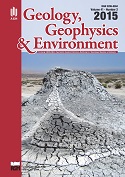The impact of the combustion waste landfill of the Skawina Power Plant on selected elements of the agricultural production area
DOI:
https://doi.org/10.7494/geol.2015.41.2.199Keywords:
ash and slag mixture, heavy metals, meadow swardAbstract
Field observations and interviews with residents of Kopanka, Ochodza and Borek Szlachecki villages indicate that the agricultural production area located near the combustion waste landfill is negatively affected. Two distinct phenomena are observed: increased dust concentration in the air and excessive soil moisture or even flooding. The aim of the study was to assess whether and to what degree the landfill affects the content of the trace elements Cd(II), Pb(II), Zn(II) and Cu in the soil and plants of the adjoining agricultural production areas. The content of Cd(II), Pb(II), Zn(II) and Cu in the soil of the studied area was within the acceptable norms specified in the regulation of the Ministry of the Environment (Dz. U. 2002 nr 165, poz. 1359). In the herbaceous vegetation growing at sampling points W150, E150, E100 and N100, the acceptable level of Cd(II) specified in the regulation of the Ministry of Agriculture and Rural Development exceeded the norms (Dz. U. 2012 poz. 203). In turn, all the plant samples Pb(II) showed acceptable levels. The content of Zn(II) and Cu in the plant material meets the criteria for fodder proposed by IUNG (Kabata-Pendias et al. 1993). The high phytoaccumulation indices for Cd(II) and Zn(II) in the plant material may be due to dust fall containing metals. However, without precise quantitative and qualitative measurements of dust fall, it is difficult to ascertain to what extent this is caused by migration from the landfill and to what extent it is a result of deposits of pollutants from other sources.Downloads
References
Baycu G., Caner H., Gonencgil B. & Eruz E., 2003. Roadside pollution of cadmium and lead in Istanbul City (Turkey) and their effect on Picea abies. Biologia, Bratislava, 58, 109–114.
Czyż H., Dzida M. & Trzaskoś M., 1996. Rola użytków zielonych w ograniczaniu skażenia powietrza metalami ciężkimi. Chemia i Inżynieria Ekologiczna, 3, 1, 101–112.
Dyguś K.H. & Madej M., 2012. Roślinność wielowariantowego doświadczenia modelowego na złożu odpadów paleniskowych energetyki węglowej. Inżynieria Ekologiczna, 30, 227–240.
Gruca-Królikowska S. & Wacławek W., 2006. Metale w środowisku. Cz. II. Wpływ metali ciężkich na rośliny. Chemia, Dydaktyka, Ekologia, Metrologia,11, 1–2, 41–56.
Gorlach E. & Gambuś F., 2000. Potencjalnie toksyczne pierwiastki śladowe w glebach (nadmiar, szkodliwość i przeciwdziałanie). Zeszyty Problemowe Postępów Nauk Rolniczych, 472, 275–296.
Jegadeesan G., Al-Abed S.R. & Pinto P., 2008. Influence of trace metal distribution on its leachability from coal flyash. Fuel, 87, 1887–1893.
Kabata-Pendias A., Motowicka-Terelak T., Piotrowska M., Terelak H. & Witek T., 1993. Ocena stopnia zanieczyszczenia gleb i roślin metalami ciężkimi i siarką: ramowe wytyczne dla rolnictwa. P – Instytut Uprawy, Nawożenia i Gleboznawstwa 53, IUNG, Puławy.
Kabata-Pendias A. & Pendias H., 2002. Biogeochemia pierwiastków śladowych. Państwowe Wydawnictwo Naukowe, Warszawa.
Łaszewska A., Kowol J., Wiechuła D. & Kwapuliński J., 2007. Kumulacja metali w wybranych gatunkach roślin leczniczych z terenu Beskidu Śląskiego i Beskidu Żywieckiego. Problemy Ekologii, 11, 6, 285–291.
Maciejewska M., Wybieralski M., Gibczyńska M. & Jurgiel-Małecka G., 2007. Metale ciężkie w popularnych trawach, ziołach i roślinach motylkowych rosnących wzdłuż dróg lokalnych numer 10 i 24 na trasie Szczecin – Poznań. Ekologia i Technika, 15, 2, 55–63.
Madej M., Siuta J. & Wasiak G., 2010. Zieleń Warszawy źródłem surowca do produkcji kompostu. Inżynieria Ekologiczna, 23, 37–49.
Niesiobędzka K. & Krajewska E., 2007. Akumulacja metali ciężkich w glebach i roślinności trawiastej przy trasach szybkiego ruchu. Environmental Protection and National Resources, 31, 278–283.
Ostrowska A., Gawliński S. & Szczubiałka Z., 1991. Metody analizy i oceny właściwości gleb i roślin. Wydawnictwo Instytutu Ochrony Środowiska, Warszawa.
Pandey V.C., Abhilash P.C., Upadhyay R.N. & Tewari D.D., 2009. Application of fly ash on the growth performance and translocation of toxic heavy metals within Cajanus cajan L. Implication for safe utilization of fly ash for agricultural production. Journal of Hazardus Materials, 166, 255–259.
Pyś J.B., 1999. Pierwiastki śladowe w roślinach pastewnych, dawkach pokarmowych i mleku krów w rejonach oddziaływania przemysłu siarkowego. Zeszyty Naukowe Akademii Rolniczej im. H. Kołłątaja w Krakowie. Rozprawy, 253, Wyd. Akademii Rolniczej, Kraków.
Referat Ochrony Środowiska Elektrowni Skawina S.A., 2012. Charakterystyka składowiska odpadów paleniskowych Elektrowni Skawina [typescript, unpublished].
Ruszkowska M. & Wojcieska-Wyskupajtys U., 1996. Mikroelementy – fizjologiczne i ekologiczne aspekty ich niedoborów i nadmiarów. Zeszyty Problemowe Postępów Nauk Rolniczych, 434, 1, 1–11.
Rozporządzenie Ministra Środowiska z dnia 9 września 2002 r. w sprawie standardów jakości gleby oraz standardów jakości ziem. Dz. U. nr 165, poz. 1359.
Rozporządzenie Ministra Rolnictwa i Rozwoju Wsi z dnia 6 lutego 2012 r. w sprawie zawartości substancji niepożądanych w paszach. Dz. U. 2012 poz. 203.
Siuta J., 2005. Rekultywacyjna efektywność osadów ściekowych na składowiskach odpadów przemysłowych. Acta Agrophysica, 5, 2, 417–425.
Szwalec A. & Mundała P., 2012. Zawartość Cd, Pb, Zn i Cu w warzywach korzeniowych uprawianych w wybranych ogrodach działkowych Krakowa. Environmental Protection and National Resources,24, 3 (57), 33–57.
Szwalec A., Mundała P. & Kędzior R., 2013. Cadmium, lead, zinc and copper content in herbaceous plants overgrowing furnace waste landfill. Environmental Protection and National Resources, 57, 53–57.
Terelak H., Stuczyński T. & Piotrowska M., 1997. Heavy metals in agricultural soils in Poland. Polish Journal of Soil Science, 30, 2, 35–42.
Wowkonowicz P., Malowaniec B. & Niesiobędzka K., 2011. Metale ciężkie w roślinach i glebach na trwałych użytkach zielonych w okolicach Warszawy. Environmental Protection and National Resources, 49, 309–319.
Zieliński J., 2007. Ocena plonu owoców róży pomarszczonej (Rosa rugosa) uprawianej na odpadach paleniskowych rekultywowanych różnymi metodami. Roczniki Akademii Rolniczej w Poznaniu. Ogrodnictwo, 383, 41, 247–251.
Downloads
Published
Issue
Section
License
Authors have full copyright and property rights to their work. Their copyrights to store the work, duplicate it in printing (as well as in the form of a digital CD recording), to make it available in the digital form, on the Internet and putting into circulation multiplied copies of the work worldwide are unlimited.
The content of the journal is freely available according to the Creative Commons License Attribution 4.0 International (CC BY 4.0)










